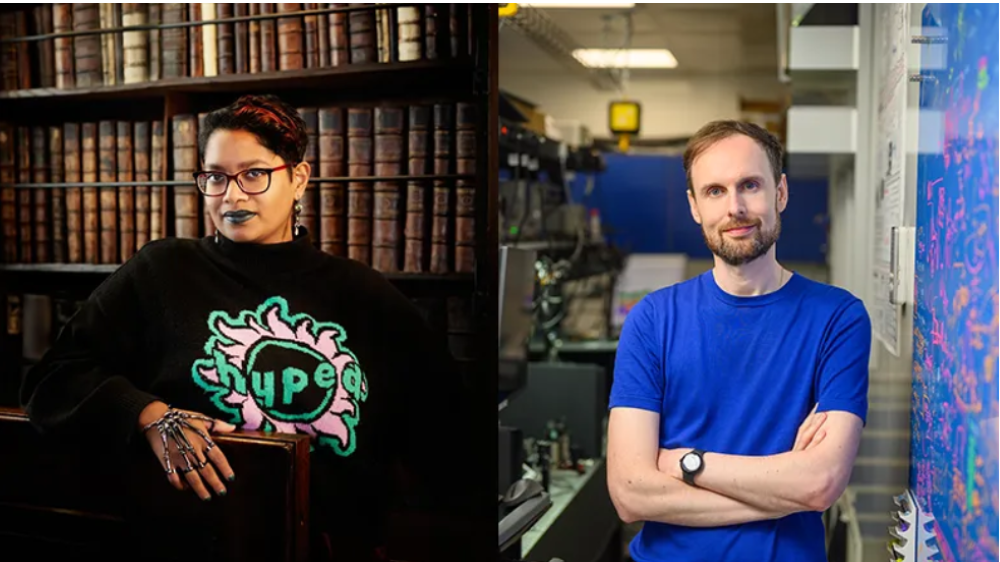By Eamonn Keyes. September,theorkneynews
Copyright theorkneynews

By Eamonn Keyes.
September 5th. The Orkney Club, Kirkwall
Poet Chandrika Narayanan-Mohan joins physicist Prof. James Millen on a journey of exploration into the quantum world. “Art and science are just different languages trying to understand the what, the why, and the how in everything around us.”
This was the first of two events I saw during the Festival that attempted to understand and show connections with the arts and the quantum world. This one was via poetry and the second was via music, which will feature later.
Professor James Millen is a Professor of Physics, an experimental quantum scientist, and Director of King’s Quantum (a multidisciplinary research initiative) in the Department of Physics at King’s College London.
He completed his MSc in Physics at Imperial College London in 2007, and his Ph. D. in experimental atomic physics at Durham University in 2011, under the supervision of Dr. M. P. A. Jones. During this work he created the world’s first gas of ultra-cold strontium Rydberg atoms.
In 2011 James moved to University College London, to work with Prof. Peter Barker in the new field of levitated optomechanics. In pioneering work, they used focussed laser beams and optical cavities to cool and control the motion of charged silica nanoparticles. Together with Dr. Janet Anders they undertook a paradigmatic study into the non-equilibrium dynamics of a Brownian particle.
James was awarded a Marie Skłodowska-Curie Research Fellowship to work in the Quantum Nanophysics group of Prof. Markus Arndt at the University of Vienna between 2015-2018. The group developed techniques which will enable the exploration of the mass limit of quantum physics in uncharted regimes.
While in Vienna, James pioneered the study of rotational optomechanics, developing the most frequency stable mechanical object ever created.
For those who need it put more simply, he can also make very small things levitate………
Chandrika Narayanan-Mohan is an Indian poet and arts administrator. She was born in New Delhi and as a child lived in the Presidential Palace as her grandfather was K.R. Narayanan, the first Dalit Indian President. Her mother is an Indian diplomat and she moved with her to Sweden and Turkey where she finished school, before living in the United States and the UK.
Her work has been widely published and has won multiple awards, and has several Artist In Residencies, one of which supported her being the 2023 Writer in Residence for the Institute of Physics. In 2024 Chandrika was selected as a Goethe-Institut Studio Quantum Artist in Residence and is currently under commission with Skein Press as part of the Play It Forward Fellowship. Her Studio Quantum artist residency led to working with James Millen and others and resulted in a ‘load of shiny new poems!
Her debut poetry collection will be published with Dedalus Press in 2026, and she remains a regular performer at spoken word events.
She spends her spare time playing tabletop games, reading fantasy fiction and eating pasta.
In our initial meeting her Dublin accent instantly contrasted with my own Belfast accent, leading me to call her a ‘Dub’ (Dubliner) whilst she referred to me as a ‘Nordie’ (Northern Irelander), but that’s how we roll in Ireland.
In person, Chandrika comes across as a somewhat exotic creature, self-confident and effusive in conversation, whereas James is no less confident but is laconic, very focused and precise.
Chandrika had been invited into James’s laboratory where she spent some time with James and his colleagues, interviewing some of them, and these interactions with both the people and the novel environment lead to inspiration for her ‘load of shiny new poems.’
Quantum states, such as where light can be particles or exhibit wave behaviour, and the well-known analogy of Schrödinger’s Cat, unsurprisingly featured in these poems, the latter in Chandrika’s poem about quantum pregnancy, a poem to a hypothetical daughter whilst in a hospital waiting room after failed contraception, where the person is unsure of the state of pregnancy, which might or might not exist, and quantum analogies were used to express the emotions that might be felt around the pregnancy and possible motherhood.
Throughout the evening, James explained what quantum physics was about, how important it is to the world we live in, and how it will become even more important in the future as quantum computers come into existence. There is so much we are still trying to discover- does quantum physics blend into ‘normal’ physics, is there a cut off point for both, or do they co-exist?
Many of these, including Chandrika’s poems, are featured in a videoed presentation on YouTube called ‘The Quantum Of Us’ This is a must for those wanted to know more from one of the experts at the cutting edge of Quantum Physics, or if you’re just interested in Chandrika’s poetry, which is best appreciated as she delivers it.
The Quantum State Of Us–
Professor Millen also described how his research had showed that very small items such as diamond dust could be levitated using strong magnetic fields, and whilst levitated could exhibit moving behaviour caused by speech and other sounds.
This interference is a problem when trying to discover quantum effects on very small particles, referred to as ‘noise’ and its elimination in experiments is key to seeing how things work at that scale, but there is usually a trade-off resulting in an acceptable reduction of noise.
Chandrika described how the personalities of the scientists she interviewed had sparked off the poems, as all were from nations outside the UK, she specifically wanted to talk to people from minoritised backgrounds and to see how this might exhibit itself in their work, but without actually discussing diversity.
The lecture led into a very interesting discussion afterwards and covered many surprising areas that were surprising and ultimately was very satisfying and much more than the initial event description had indicated. Cutting edge scientifically and artistically.
Also by Eamonn Keyes